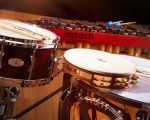How to Build a Home Music Production Setup with Limited Space
As someone who has been passionate about music production for years, I understand how challenging it can be to create a high-quality music production setup, especially when you're working with limited space. Whether you live in a small apartment or just want to maximize the use of a compact room, it is entirely possible to build a great music production studio that doesn’t take up too much room. In this article, I’ll share tips, tricks, and essential equipment recommendations that will help you set up a functional home studio even in tight spaces.
1. Choose a Small, Functional Desk
The foundation of any music production setup is the desk. When space is limited, it’s essential to find a desk that fits your gear without overwhelming the space. Opt for a compact desk that can accommodate a computer, audio interface, and keyboard. You don't need a huge desk with plenty of storage if you focus on just the essentials. One tip I’ve learned is to look for desks that offer cable management features, as keeping wires tidy is key to maximizing space and reducing clutter.
2. Invest in Compact and Essential Equipment
When it comes to building a home music production setup with limited space, less is more. There’s no need to fill your space with unnecessary equipment. Stick to the essentials and make sure the gear you choose fits within your space limitations. A few items that I personally recommend include:
- Audio Interface: The heart of any setup, which allows you to connect your instruments and microphones to your computer. Look for compact interfaces like the Focusrite Scarlett 2i2.
- Studio Monitors: While studio monitors are important, you don’t need large speakers that take up lots of space. Consider compact models like the KRK Rokit 5 or Yamaha HS5.
- Headphones: High-quality headphones like the Audio-Technica ATH-M50x are perfect when you need to save space but still want accurate sound.
3. Optimize Your Workflow with Portable Controllers
If you're someone who enjoys using physical controllers while making music, but space is limited, it’s worth looking into smaller, portable options. A MIDI keyboard with a minimalistic design can give you the control you need while occupying minimal space. My personal favorite is the Akai MPK Mini, which packs a lot of power into a compact form.
4. Use Vertical Space and Wall Mounts
When dealing with limited space, it’s important to make use of every inch. Consider mounting your monitors on adjustable wall mounts, which will free up desk space and create a more ergonomic setup. Additionally, using wall shelves for storing items like headphones, small audio gear, or even your microphone can save space and keep your desk area clutter-free.
5. Optimize Sound Treatment Without Taking Up Space
Sound treatment is crucial for improving the quality of your recordings, but large panels can take up a lot of space. Instead of bulky foam panels, consider thinner, more aesthetic alternatives like acoustic curtains, which can be mounted on the wall or hung from the ceiling. You can also use bass traps and corner foam to optimize sound without overwhelming your space.
6. Cable Management is Key
In any small music studio, cables can quickly become a chaotic mess. Effective cable management is crucial for maintaining a clean and functional space. Use cable ties, cable trays, or even under-desk cable organizers to keep everything neat. I’ve found that labeling cables can be a huge time-saver when troubleshooting or making adjustments to your setup.
7. Choose Software that Fits Your Workflow
In addition to physical equipment, software plays a huge role in music production. With limited space, it’s important to choose a digital audio workstation (DAW) that meets your needs and is lightweight enough to not consume too much memory or storage. Popular DAWs like Ableton Live, FL Studio, and Logic Pro X are excellent choices, but consider your specific needs, such as plugin support, ease of use, and system compatibility.
8. Keep Your Space Organized and Clean
Finally, don’t underestimate the power of organization. When you’re working in a confined area, it’s easy for your equipment to become cluttered. Regularly declutter your space by removing any non-essential items and cleaning up any cables or peripherals that are not in use. An organized space can help you focus more on your music and less on distractions.
Conclusion: Creating a Home Studio That Works for You
Building a home music production setup with limited space is not only possible but can also be incredibly rewarding. With a focus on choosing compact, essential equipment, optimizing your workflow, and maximizing the space you have, you can create a professional-level setup without needing a large room. Remember, the key is to stay organized, prioritize the tools you need, and always make sure your setup fits your unique workflow. Happy producing!








